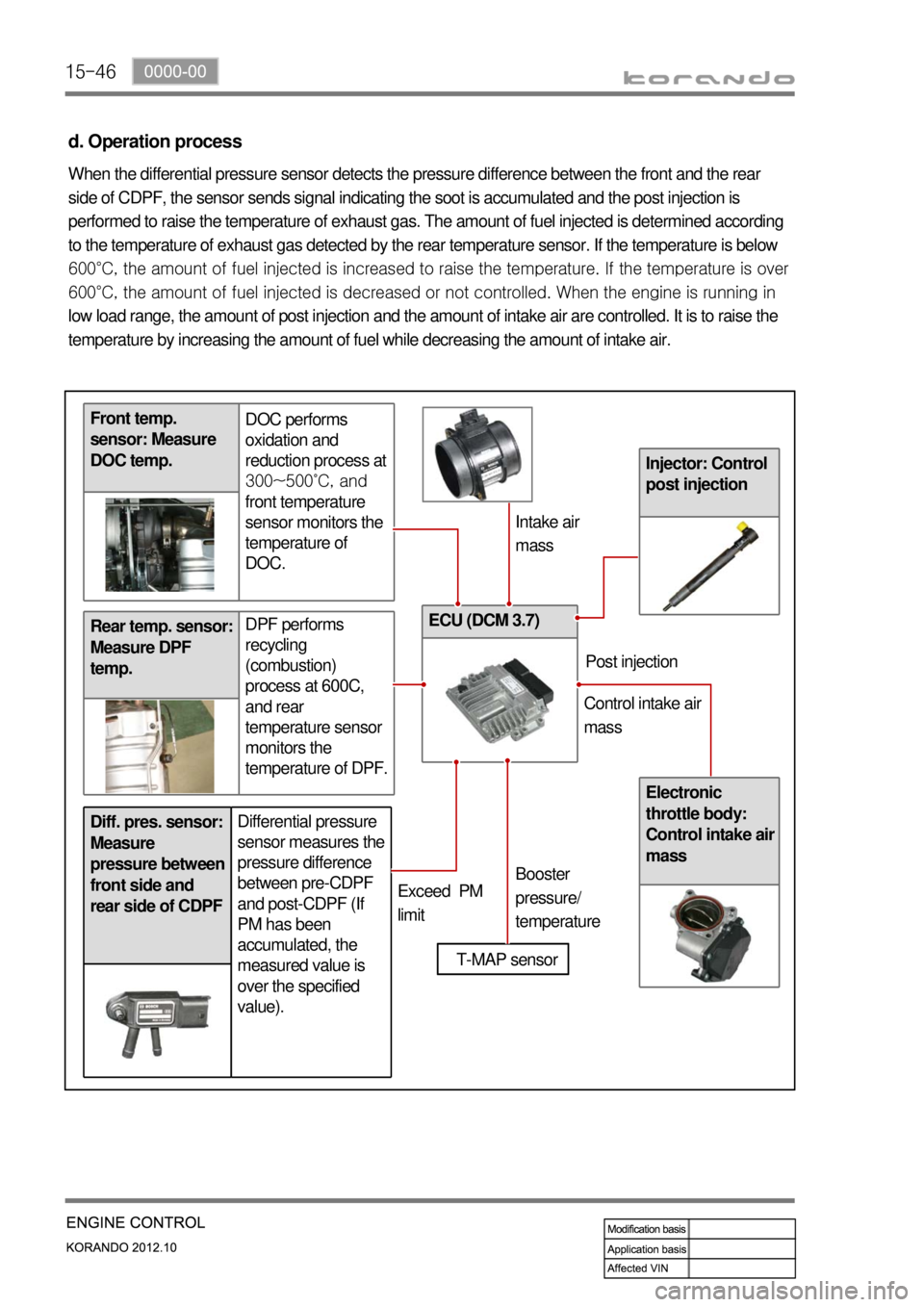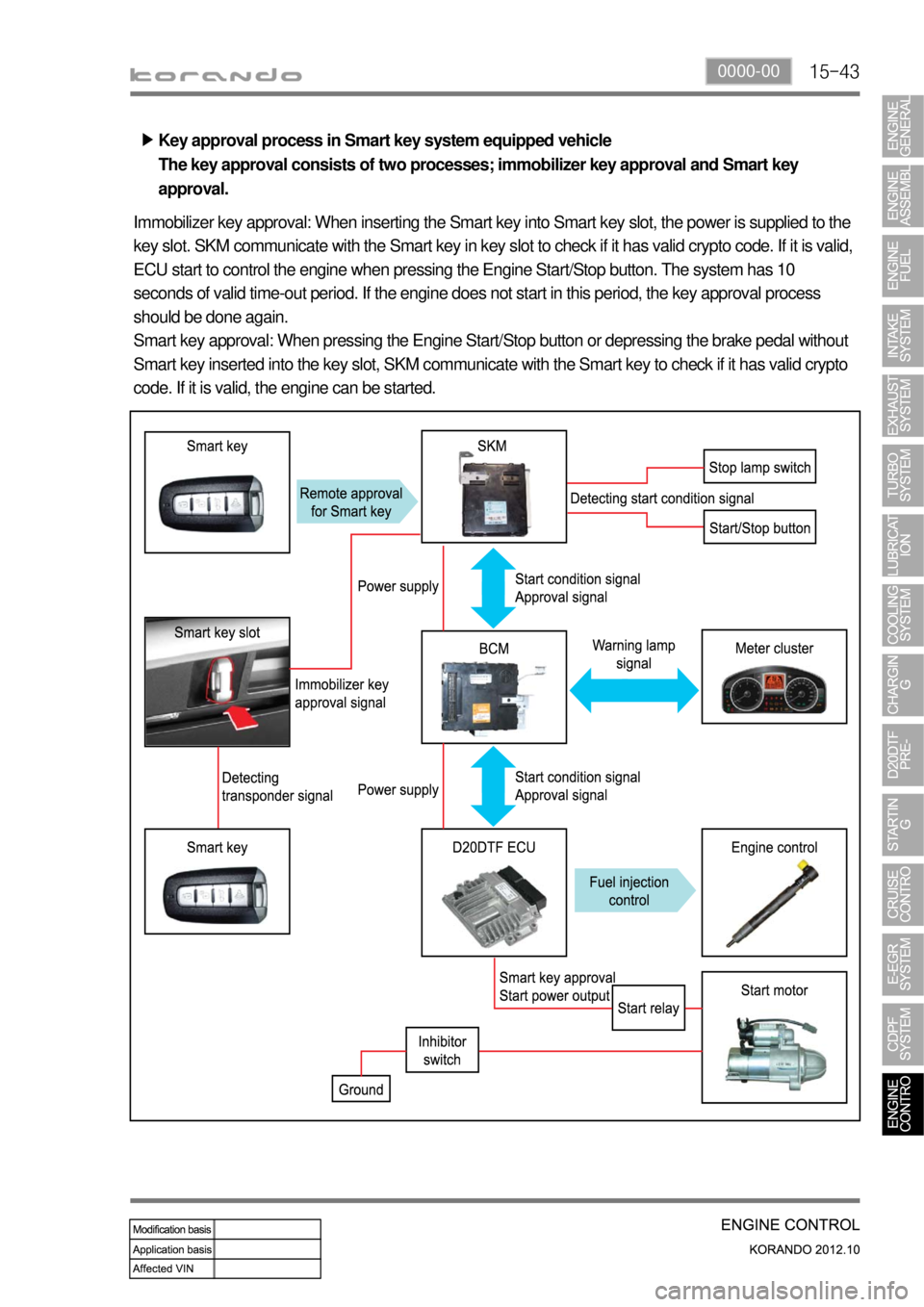SSANGYONG KORANDO 2012 Workshop Manual
KORANDO 2012
SSANGYONG
SSANGYONG
https://www.carmanualsonline.info/img/67/57504/w960_57504-0.png
SSANGYONG KORANDO 2012 Workshop Manual
Page 316 of 1082
15-40
Meter clusterImmobilizer
antenna
(10) Immobilizer control
a. Overview
The Immobilizer System provides an additional theft deterrent to the vehicle in which it is installed and
prevents it from being started by unauthorized persons. The transponder integrated in the key and the
engine control unit have the same code. When the ignition key with the integrated transponder is turned
to the ON position, the ECU (Engine Control Unit) checks the crypto code of the key and, if correct,
allows the vehicle to start the engine.
For details, refer to Chapter "BCM".
b. Components
Basic components (ignition key system) ▶
Immobilizer key
Start motor
BCM
ECU
D20DTF
Page 317 of 1082
15-410000-00
Key approval process ▶
When turning the ignition switch to ON position, the power is supplied to BCM and ECU. ECU
communicate with the immobilizer key to check if it is valid crypto code. If it is valid, ECU start to control
the engine when turning the ignition switch to START position.
The system has 10 seconds of valid time-out period. If the engine does not start in this period, the key
approval process should be done again.
Page 318 of 1082
15-42
c. Components for immobilizer with Smart key system
Components (For antenna, refer to Chapter “SKM”) ▶
Smart key slot
Smart key
Start motor
Meter
cluster
BCM
SKMD20DTF
ECU
Page 319 of 1082
15-430000-00
Key approval process in Smart key system equipped vehicle
The key approval consists of two processes; immobilizer key approval and Smart key
approval. ▶
Immobilizer key approval: When inserting the Smart key into Smart key slot, the power is supplied to the
key slot. SKM communicate with the Smart key in key slot to check if it has valid crypto code. If it is valid,
ECU start to control the engine when pressing the Engine Start/Stop button. The system has 10
seconds of valid time-out period. If the engine does not start in this period, the key approval process
should be done again.
Smart key approval: When pressing the Engine Start/Stop button or depressing the brake pedal without
Smart key inserted into the key slot, SKM communicate with the Smart key to check if it has valid crypto
code. If it is valid, the engine can be started.
Page 320 of 1082
15-44
Front temp. sensor
(11) CDPF control
a. Overview
As the solution for environmental regulations and PM Particle Material) of diesel engine, the low emission
vehicle is getting popular. This vehicle is equipped with an extra filter to collect the soot and burn it again
so that the amount of PM in the exhaust gas passed through the DOC (Diesel Oxidation Catalyst) is
reduced. The CDPF (Catalyst & Diesel Particulate Filter) is an integrated filter including DOC (Diesel
Oxidation Catalyst) and DPF (Diesel Particulate Filter).
For details, refer to Chapter "CDPF".
b. Components
Rear temp. sensorCDPF (DOC+DPF)
Throttle valveD20DTF ECUDifferential pres.
sensorOxygen sensor
Page 322 of 1082

15-46
Rear temp. sensor:
Measure DPF
temp.DPF performs
recycling
(combustion)
process at 600C,
and rear
temperature sensor
monitors the
temperature of DPF.
Differential pressure
sensor measures the
pressure difference
between pre-CDPF
and post-CDPF (If
PM has been
accumulated, the
measured value is
over the specified
value).Diff. pres. sensor:
Measure
pressure between
front side and
rear side of CDPF
Injector: Control
post injection
Front temp.
sensor: Measure
DOC temp.DOC performs
oxidation and
reduction process at
300~500˚C, and
front temperature
sensor monitors the
temperature of
DOC.
Electronic
throttle body:
Control intake ai
r
mass
ECU (DCM 3.7)
d. Operation process
When the differential pressure sensor detects the pressure difference between the front and the rear
side of CDPF, the sensor sends signal indicating the soot is accumulated and the post injection is
performed to raise the temperature of exhaust gas. The amount of fuel injected is determined according
to the temperature of exhaust gas detected by the rear temperature sensor. If the temperature is below
600°C, the amount of fuel injected is increased to raise the tem
perature. If the temperature is over
600°C, the amount of fuel injected is decreased or not controlled. When the engine is running in
low load range, the amount of post injection and the amount of intake air are controlled. It is to raise the
temperature by increasing the amount of fuel while decreasing the amount of intake air.
T-MAP sensor
Intake air
mass
Exceed PM
limitBooster
pressure/
temperaturePost injection
Control intake air
mass
Page 324 of 1082
15-48
3) Input/Output for CAN communication
(1) Configuration of CAN (P-CAN/B-CAN)
CAN Topology communicate with system units. There are two types (P-CAN and B-CAN) of
communication according to the communication speed. Instrument cluster, BCM and diagnostic
connector use both types of communication. And, ECU, ABS & ESP, TCU, GCU, E-coupling and EPS
unit use P-CAN communication because it is faster than B-CAN. The terminal resistances are installed in
ECU and BCM.
Abbreviation Function
GCU Glow Control Unit
EPS Electronic Power Steering Unit
BCM Body Control Module
Page 336 of 1082
01-12
4. CODING AND SETUP
1) Engine Variant Coding
Description Coding
Vehicle speed input to ECUCAN
with ABS or ESP: CAN
WIRE
Fan3 Relays
3 Relays
PWM fan
Auto cruiseNO
with Auto cruise system: YES
YES
Engine level controlNO
without Engine level control system: NO
(Korando)
YES
G-sensorNO
with 2WD ABS and non-ABS: NO
with 4WD ABS and ESP: YES
YES
Smart keyNO
with Smart key: YES
YES
Page 337 of 1082
01-130000-00
1. ENGINE COMPARTMENT
Coolant reservoir
OCV
Ignition coil
Rear oxygen sensor connector
Front oxygen sensor connector
Coolant temperature sensor
Purge control solenoid valve
Engine ECU
Battery
Fuse box 1.
2.
3.
4.
5.
6.
7.
8
9.
10.HECU assembly
Alternator
Fuel rail assembly
Injector
Intake manifold
Oil dipstick gauge
VIS solenoid valve
T-MAP sensor
Electronic throttle body
Air cleaner assembly 11.
12.
13.
14.
15.
16.
17.
18.
19.
20.
Page 338 of 1082
01-14
Engine ECU
2. FUEL SYSTEM
Engine compartment
Purge control solenoid
valveFuel railInjector









